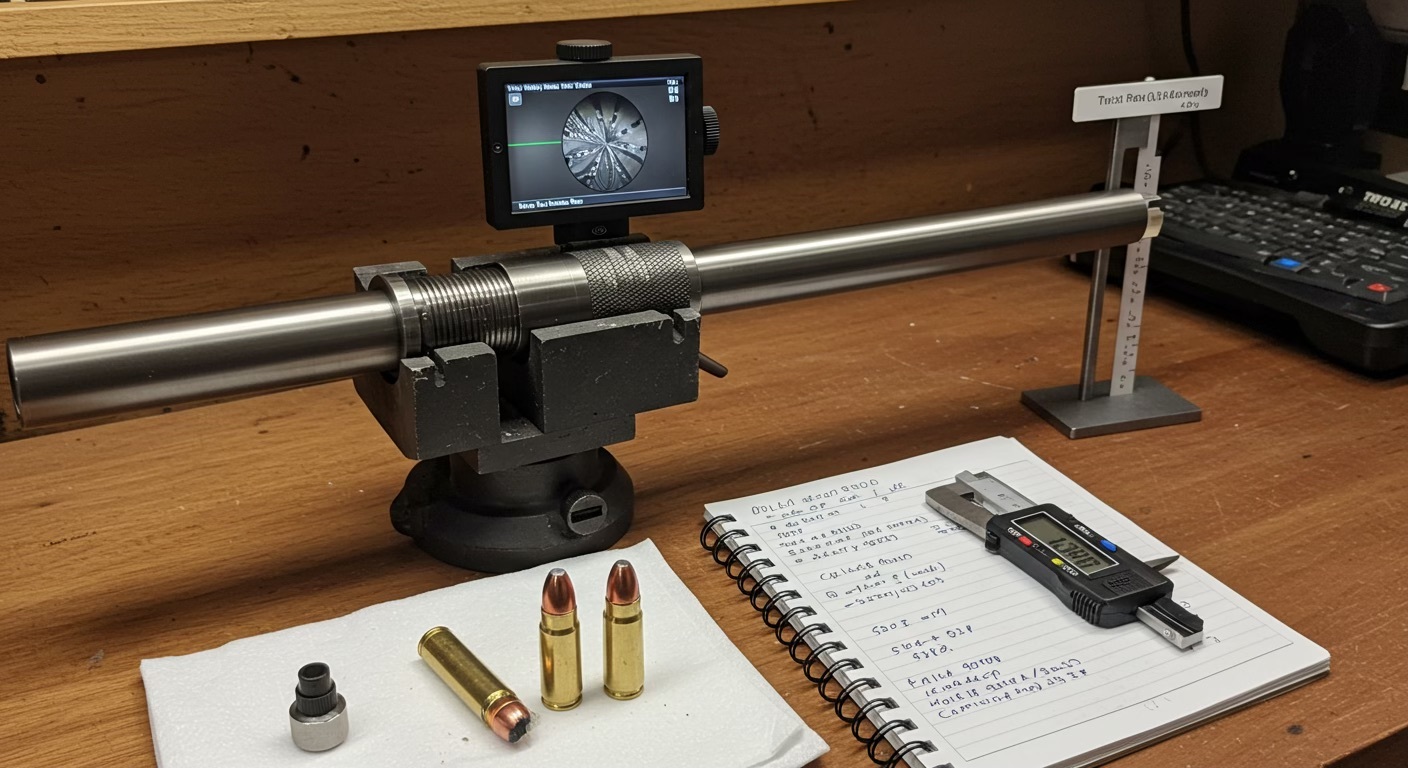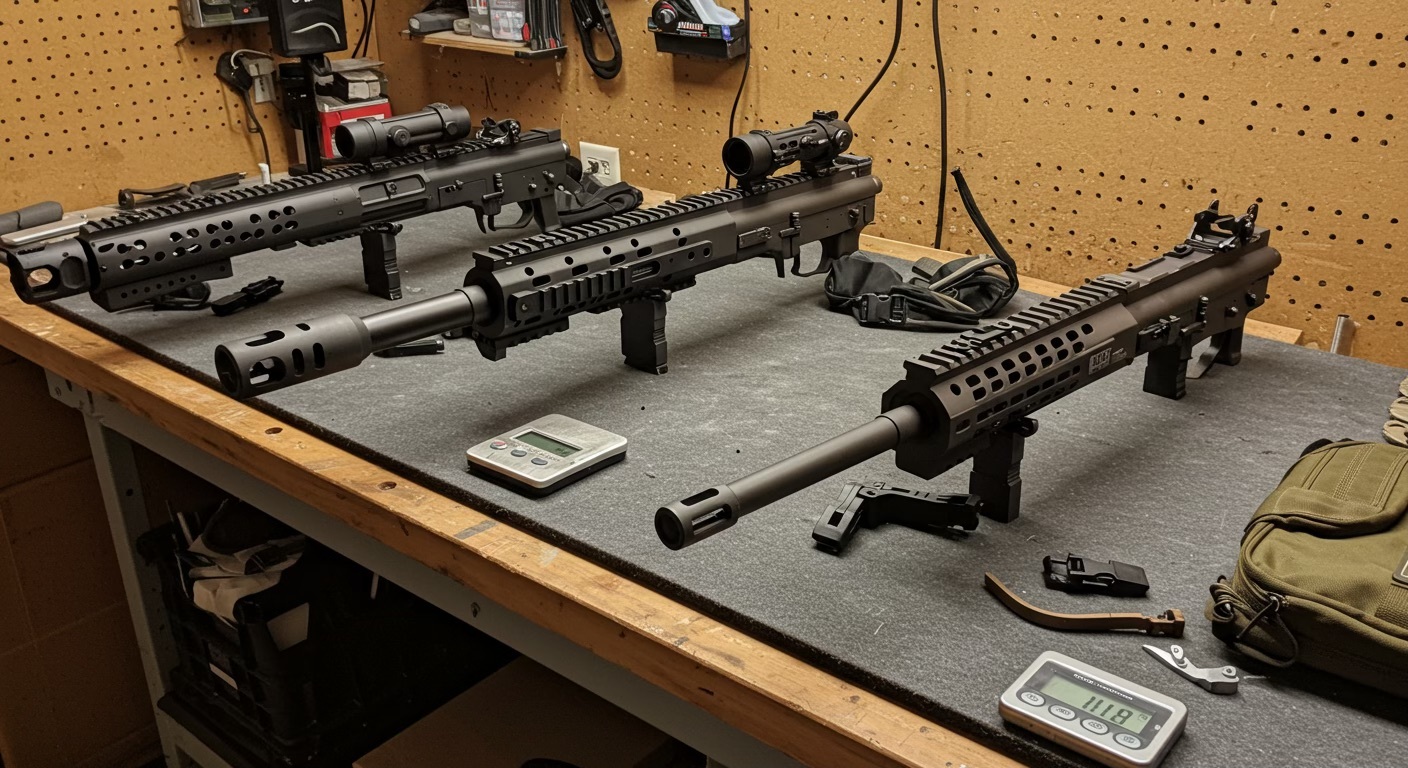The landscape of high-caliber AR builds has transformed dramatically in recent years, with the 458 SOCOM cartridge standing out as a powerhouse option for serious shooters.
As we move through 2025, this formidable round continues to gain popularity among hunters, tactical shooters, and firearm enthusiasts seeking maximum stopping power in the familiar AR-15 platform. The cartridge was originally developed for special operations applications, delivering exceptional terminal ballistics in a package that maintains compatibility with standard AR-15 lower receivers.
What makes this caliber truly remarkable is its ability to deliver devastating energy, comparable to a 45-70 Government round, while utilizing the ergonomics and customization options of America's most popular rifle platform.
If you're planning a high-caliber build this year, the quality and specifications of your barrel deserve particular attention, especially when sourcing from AR15 Parts, where every component is curated to support superior accuracy, reliability, and performance across your entire build.
Discover Why 458 SOCOM Is Still a Top Performer This Year
The staying power of the 458 SOCOM in 2025's competitive firearms market isn't accidental. This cartridge delivers a unique combination of attributes that serious shooters continue to value year after year. The cartridge offers exceptional stopping power with projectiles typically ranging from 300 to 600 grains, a stark contrast to the standard 55-grain 5.56mm NATO round common to most AR platforms.
For hunters pursuing large game, it provides the terminal performance needed for ethical harvesting at reasonable distances. The cartridge's energy transfer and substantial wound channel make it particularly effective for hog hunting and other large game applications where one-shot stops are critical.
With proper barrel selection, shooters can expect consistent sub-MOA accuracy at distances up to 200 yards, which is more than sufficient for most hunting scenarios. Additionally, the cartridge shines in home defense applications where overpenetration concerns make standard rifle calibers problematic.
The large, slower-moving projectiles deliver massive energy transfer while being less likely to penetrate multiple walls, which is a critical safety consideration in residential settings. When paired with quality components from AR15 Parts, a properly built cartridge can serve as a versatile tool for multiple applications.
Choose the Right Barrel for Peak 458 SOCOM Performance
Choosing the right barrel for your 458 SOCOM build requires understanding several critical factors that will directly impact performance. Unlike smaller calibers, it places significant demands on barrel construction due to its substantial pressure and recoil characteristics.
Material Selection
Barrel material dramatically influences durability, accuracy, and overall shooting experience. For the 458 SOCOM, two primary options dominate the market:
- Stainless Steel: Offers excellent accuracy potential and corrosion resistance. The 16" 458 SOCOM Upper with Satern Heavy SS Barrel represents the premium option for precision-focused builds. Stainless steel typically provides better accuracy but may wear slightly faster under high-volume shooting conditions.
- Chrome-Moly (Parkerized): Delivers exceptional durability with good accuracy. The 16" 458 SOCOM Upper with Heavy Parkerized Barrel offers a balance of performance and longevity, making it ideal for shooters who expect to put significant rounds downrange.
Barrel Length Considerations
The barrel length for your rifle directly affects ballistic performance, handling characteristics, and practical applications. Most experts agree that the sweet spot for barrels falls between 16-18 inches, providing optimal velocity without excessive weight or unwieldy proportions.
Shorter barrels (under 16 inches) require NFA registration as short-barreled rifles but offer improved maneuverability for tactical applications. Longer barrels may provide marginal velocity gains, but typically add unnecessary weight and bulk to the platform. For most users, the standard 16-inch configuration delivers the best balance of performance, legality, and handling characteristics.
Dial in Accuracy with the Best Twist Rates and Rifling Types

The barrel's twist rate, which indicates how quickly the rifling completes one full rotation, plays a decisive role in accuracy. Given the wide range of bullet weights available for this caliber (300-600 grains), selecting the appropriate twist rate becomes especially important.
Most quality barrels feature a 1:14 twist rate, which effectively stabilizes the common bullet weights used in this caliber. This twist rate provides optimal performance with the popular 300-350 grain projectiles while still adequately stabilizing heavier options. For shooters planning to exclusively use heavier bullets (400+ grains), a slightly slower 1:12 twist may offer improved stability and accuracy.
Rifling profile also matters significantly. Traditional land-and-groove rifling provides reliable performance, while polygonal rifling may offer marginally better velocity and barrel life. Either option can deliver excellent results when properly manufactured. The key consideration is the quality of machining rather than the specific rifling type.
Boost Feeding Reliability with Smart Ramp and Chamber Specs
One of the most critical yet often overlooked aspects of 458 SOCOM barrels is proper feed ramp design. The substantial diameter of the rounds creates unique feeding challenges compared to smaller calibers. Quality barrels feature properly designed M4-style extended feed ramps that ensure reliable feeding even with the varied bullet profiles common to this caliber.
The feed ramp angle and polish significantly impact reliability, particularly with specialized ammunition types like hollow points or flat-nosed projectiles. Premium manufacturers machine these critical surfaces to precise specifications and apply appropriate finishing processes to enhance feeding reliability.
Chamber dimensions also require careful attention. SAAMI-spec chambers ensure consistent headspacing and extraction, while properly executed throat dimensions help with feeding and accuracy. When evaluating barrel options, look for manufacturers who specifically address these design elements rather than simply adapting standard AR barrels to the larger caliber.
Reduce Recoil with the Right Muzzle Device and Threading
The substantial recoil generated by the 458 SOCOM barrels makes muzzle device selection particularly important. Most quality barrels come threaded in 5/8x32 pitch, which has become the standard for this caliber. This threading pattern allows for the installation of various muzzle devices designed to tame the considerable recoil.
The most effective options include:
- Compensator/Brake Hybrids: Redirect gas to counter both muzzle rise and rearward recoil
- Linear Compensators: Direct blast forward, making the rifle more comfortable to shoot in confined spaces
- Traditional Brakes: Maximize recoil reduction, but increase side blast and noise
- Sound Suppressors: Require appropriate threading and barrel design considerations
For 2025 builds, the trend continues toward muzzle devices that balance recoil management with blast mitigation. When selecting your barrel, consider whether it includes an appropriate muzzle device or if you'll need to purchase one separately. The thread protector option on the 16" 458 SOCOM Upper with Satern Heavy SS Barrel gives you flexibility to choose your preferred muzzle device later.
Match Barrel Profile and Weight to Your Application

The barrel profile directly affects weight distribution, heat dissipation, and shooting characteristics. For the 458 SOCOM, heavy or bull profiles have become standard due to the caliber's substantial recoil and pressure. These thicker profiles provide improved rigidity and heat management, contributing to consistent accuracy even during extended firing sessions.
When selecting a barrel profile, consider your primary application:
- Hunting applications benefit from a balanced approach: heavy enough for accuracy but not so heavy as to become burdensome in the field
- Tactical/defensive builds may emphasize maneuverability with slightly lighter profiles
- Competition or precision-focused builds often benefit from the heaviest profiles available, maximizing stability and heat capacity
The substantial diameter of barrels naturally results in heavier builds compared to smaller calibers. A complete upper with a 16-inch heavy profile barrel typically weighs between 4-5 pounds before adding optics or accessories. This forward weight can help manage recoil, but requires consideration when planning your overall build.
Frequently Asked Questions
What makes the 458 SOCOM different from other large-caliber AR options?
The 458 SOCOM offers a unique combination of massive stopping power and AR-15 compatibility. Unlike other big-bore options like the 50 Beowulf or 450 Bushmaster, it was specifically designed for special operations applications, emphasizing terminal performance and reliability.
It uses a rebated rim design that allows for standard AR-15 bolt faces with only the extractor requiring modification. This means most of your existing AR parts remain compatible, making it a cost-effective upgrade path compared to other large-caliber options that might require more specialized components.
How much barrel life can I expect from a quality 458 SOCOM barrel?
With proper care, a premium 458 SOCOM barrel should deliver 2,000-3,000 rounds of accurate service life before noticeable accuracy degradation begins. Stainless steel barrels typically offer superior initial accuracy but may wear slightly faster than chrome-moly alternatives.
Factors affecting barrel life include firing schedule (rapid strings generate more heat), cleaning regimen, ammunition selection, and manufacturing quality. Regular inspection of the throat area (where erosion typically begins) will help monitor barrel condition over time.
Can I use my existing AR-15 lower receiver with a 458 SOCOM upper?
Yes, the 458 SOCOM was specifically designed to function with standard AR-15 lower receivers. The cartridge headspaces on the shoulder and uses the same bolt face diameter as the 5.56mm NATO, requiring only an altered extractor.
However, you'll need a specialized magazine follower or dedicated magazines for reliable feeding. Standard 5.56mm magazines can be used, but they'll only hold about 10 rounds due to the cartridge's substantially larger diameter. Additionally, a heavier buffer system is recommended to manage the increased recoil.
What's the effective range of a 458 SOCOM with a quality barrel?
With a premium barrel and appropriate ammunition, the 458 SOCOM is typically effective up to 200-250 yards for hunting applications. While the cartridge is capable of longer shots, its rainbow-like trajectory beyond this distance makes precision challenging.
At closer ranges (under 150 yards), the 458 SOCOM delivers devastating terminal performance with minimal holdover concerns. For defensive or tactical applications, the effective range is generally considered to be within 100 yards, where the cartridge's substantial energy transfer and stopping power are maximized.
How does barrel finish affect 458 SOCOM performance and maintenance?
Barrel finish plays a significant role in both performance and maintenance requirements. Stainless steel barrels offer excellent corrosion resistance without additional treatment, but may show copper fouling more readily.
Parkerized chrome-moly barrels provide enhanced durability and corrosion resistance, requiring less immediate maintenance in adverse conditions. Both options can deliver excellent accuracy, but stainless typically has a slight edge in precision applications.
For maintenance, stainless barrels generally clean up more easily but may require more frequent attention to prevent copper buildup, while parkerized barrels are more forgiving of delayed maintenance but sometimes need more aggressive cleaning methods.
Build Smarter with the Right 458 SOCOM Barrel in 2025
As we progress through 2025, the 458 SOCOM continues to offer an unmatched combination of stopping power, compatibility, and versatility for serious shooters. The barrel you select serves as the foundation of your build's performance, directly influencing accuracy, reliability, and overall shooting experience.
Whether you opt for the precision-focused stainless steel option or the durable parkerized variant, investing in a quality barrel from a reputable manufacturer will pay dividends in your shooting experience.
For hunters, tactical users, and enthusiasts seeking maximum performance from the AR platform, the 458 SOCOM represents an exceptional choice that delivers impressive results when paired with properly selected components.
Connect with AR15 Parts for 458 SOCOM Barrel Solutions
Barrel selection makes or breaks a build, affecting everything from accuracy to recoil control. At AR15 Parts, we focus on helping builders get the most from this powerhouse caliber by offering carefully vetted barrels, uppers, and accessories designed specifically for performance.
Reach out to AR15 Parts today for expert recommendations and access to the top-performing barrels on the market. Whether you’re hunting, defending, or just pushing your build to the next level, our components help you shoot with confidence.

